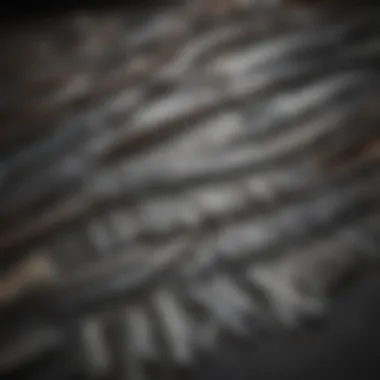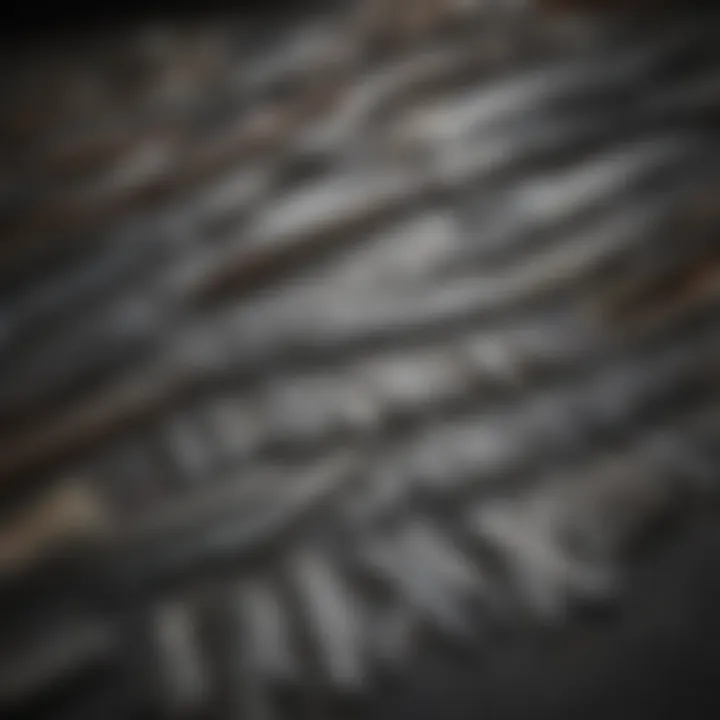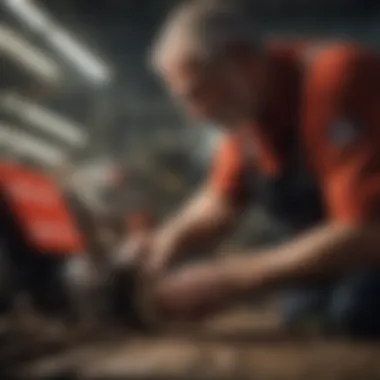Milwaukee Cutting Blades: Innovations & Applications


Intro
Milwaukee cutting blades represent a significant advancement in the tools used for agriculture and horticulture. In an industry where precision and efficiency are key, these blades stand out due to their innovative design and engineering. Their application ranges from general landscaping tasks to more complex agricultural techniques. This article explores these cutting blades in depth, focusing on their types, materials, performance, and best maintenance practices. The aim is to provide both novice users and seasoned professionals with the insights needed to utilize these tools effectively.
Topic Overview
Definition and Importance
Cutting blades from Milwaukee are specialized tools designed to perform various cutting tasks in agriculture and horticulture. These tools are crucial for enhancing productivity, ensuring accuracy, and reducing manual effort needed during operations. They come in different styles and configurations, each tailored for specific applications, making them essential for farmers and horticulturists.
Brief History and Evolution
The evolution of Milwaukee cutting blades reflects ongoing innovations in tool manufacturing. Originally, cutting implements were rudimentary, often made from wood or simple metals. Over time, advancements in metallurgy introduced durable materials, allowing for the creation of blades that could withstand intense usage. Milwaukee has continued this tradition of innovation, consistently bringing new designs that incorporate cutting-edge technology and materials.
Key Techniques and Innovations
Sustainable Farming Practices
Sustainability is an essential focus in modern agriculture. Milwaukee cutting blades contribute to these practices by facilitating more efficient cutting, reducing waste. Tools that can perform precise cuts lower the risk of damage to crops and surrounding plants. This approach supports sustainable growth methods and ensures healthier yields.
Advanced Agronomic Technologies
Milwaukee integrates advanced technologies in their blade design. Features like enhanced sharpness, heat resistance, and anti-corrosion properties are just a few examples. These innovations allow the blades to perform better over longer periods, requiring less frequent replacement and thus saving resources.
Practical Applications
Step-by-Step Guides
Using Milwaukee cutting blades effectively requires a clear understanding of their features. Here are some basic steps for optimal use:
- Select the right blade for the specific task and material.
- Inspect the blade for any damage or wear before use.
- Maintain a steady and firm grip while cutting for better control.
- Follow the manufacturer’s guidelines for storage and maintenance after use to prolong the blade’s life.
Case Studies or Real-World Examples
Several farms have successfully integrated Milwaukee cutting blades into their operations. For instance, a vineyard in California reported increased efficiency and reduced downtime when using these blades for pruning activities. By adopting the right blade type, they managed to enhance the growth cycle of the vines.
In another application, a landscaping business utilized Milwaukee blades for tree trimming, which resulted in quicker job completion and a higher quality of finish compared to traditional tools.
"The proper tools can enhance not just productivity but also the quality of the work we do in agriculture."
These examples illustrate how leveraging the right tools enhances not only efficiency but also the overall effectiveness of agricultural tasks.
Overview of Milwaukee Cutting Blades
Milwaukee cutting blades hold a significant position in the realm of agricultural tools. Understanding their design, purpose, and functionality is paramount for users seeking efficiency and effectiveness in their tasks. This section aims to provide a foundational knowledge about Milwaukee cutting blades, exploring their historical context as well as current market dynamics that influence their usage.
History and Evolution
The journey of Milwaukee cutting blades began with a focus on durability and efficiency. Milwaukee has a long-standing history in tool manufacturing, tracing back to the late 1920s. Over the decades, the company has evolved its blade designs to adapt to changing agricultural practices and advancements in material science. Early cutting blades were often made from simple carbon steel. As technology progressed, Milwaukee shifted to high-speed steel and carbide-tipped blades, which provided enhanced cutting precision and durability.
Innovation continued to drive the design of these blades, with the introduction of specialized options catering to diverse agricultural needs. This historical context is crucial for understanding the current capabilities of Milwaukee cutting blades and their relevance in modern agricultural work.
Current Market Trends
Currently, Milwaukee cutting blades are recognized for their leading role within the market. Farmers and agricultural enthusiasts are increasingly leaning towards tools that maximize productivity while minimizing effort. The trend toward high-efficiency tools fits perfectly with Milwaukee's product offerings, which emphasize resilience and performance. Additionally, the rise of sustainability in farming practices is pushing manufacturers to develop blades that not just perform well but also reduce waste and energy consumption.
Moreover, advancements in technology have made it easier for users to find blades suited for specific applications. For instance, the ability to select blades based on materials being cut—whether wood, metal, or composites—enhances user experience and satisfaction. Tools like these are no longer seen just as equipment, but rather as essential parts of a successful farming operation. This reflects the ongoing demand for innovation and quality in cutting tools, not merely for functionality but for strategic advantages in agriculture.
Types of Milwaukee Cutting Blades
Understanding the different types of Milwaukee cutting blades is crucial for anyone involved in agriculture and horticulture. Each blade type serves specific purposes and is designed to address varying cutting needs. This knowledge helps users select the right blade for their task, enhancing efficiency and productivity.


General Purpose Blades
General purpose blades from Milwaukee are crafted to handle a wide range of cutting tasks. Their versatility is one of the key benefits they offer to users. These blades can cut through various materials, making them a favorite among farmers and contractors alike.
One prominent feature of these blades is their ability to maintain sharpness over extended use. This quality reduces the necessity for frequent replacements, translating to lower operational costs in the long run. Additionally, their design caters to both speed and precision, allowing for smooth cuts without much effort.
Specialized Blades
Specialized blades are tailored for specific tasks, providing enhanced performance compared to general purpose counterparts. These blades often incorporate advanced technologies, increasing usability and efficiency.
Shear Blades
Shear blades are specifically designed for tasks that require clean and precise cuts. Their sharp edges make them ideal for trimming and shaping materials, which is especially useful in agricultural settings where accuracy is paramount. The unique characteristic of shear blades is their ability to minimize damage to the material being cut, which can be a crucial factor in crop health and yield.
A beneficial aspect of shear blades is their capability to handle both soft and tough materials. This flexibility allows users to rely on one tool for multiple applications, which can save time and increase productivity. However, care must be taken with shear blades; they require regular maintenance to keep their edges in top condition.
Multi-Task Blades
Multi-task blades offer an all-in-one solution for users who encounter varying materials and cutting demands. These blades are designed for efficiency, enabling users to tackle multiple jobs without switching tools frequently. The key characteristic of multi-task blades is their robustness, allowing them to withstand rigorous use without compromising performance.
A distinct feature of these blades is their adaptability. They can handle different types of materials, which includes both soft woods and tougher metals. This versatility is particularly advantageous for users who operate in varied environments. On the downside, multi-task blades might lack the precision of more specialized blades, making them less suitable for highly intricate tasks.
Blades for Specific Materials
Blades designed for specific materials are fundamental in ensuring optimal cutting performance. Different materials require different blade characteristics for effective cutting, and Milwaukee has designed these blades to meet distinct needs.
Wood Cutting Blades
Wood cutting blades are engineered to slice through timber with ease, making them indispensable for agricultural practices that involve tree management or wood processing. The prominent feature of these blades is their tooth design, which enhances cutting speed and smoothness.
A major advantage of wood cutting blades is their capacity to handle various wood types, from softwoods to hardwoods. This feature makes them highly sought after among users who have diverse wood cutting needs. However, wear and tear may occur if used on non-wood materials, which can shorten their lifespan and effectiveness.
Metal Cutting Blades
Metal cutting blades are indispensable for tasks that require precision cuts through metals. Milwaukee’s designs focus on strength and durability, making it suitable for tough jobs like stripping down old machinery or creating custom fittings.
The key characteristic of metal cutting blades is their hardened edges and specific tooth geometries aimed at efficiently slicing through metals. Users find these blades beneficial as they greatly reduce the risk of malfunctions during cutting tasks. Despite their advantages, metal cutting blades usually require additional caution and should be paired with appropriate safety gear, as their sharpness and power can pose risks during usage.
Material Composition of Cutting Blades
Understanding the material composition of cutting blades is fundamental in assessing their performance, durability, and suitability for various applications. The choice of materials influences not only the efficiency of a blade but also its lifespan and adaptability to different cutting tasks. This section explores the essential elements that contribute to the effectiveness of Milwaukee cutting blades.
Types of Steel Used
Milwaukee cutting blades usually utilize high-carbon steel and alloy steels. High-carbon steel contains a higher percentage of carbon, which enhances toughness and wear resistance. These properties are critical for maintaining sharpness over extended periods, which is particularly important for intensive agricultural tasks.
Alloy steels may include elements such as chromium and vanadium. Chromium enhances hardness and corrosion resistance, while vanadium contributes to wear resistance and strength. The specific mix of these metals results in blades capable of withstanding the stresses of heavy use. This adaptability makes them suitable for a variety of environments, from farms to industrial settings.
Coating Technologies
To further improve the performance of cutting blades, Milwaukee employs advanced coating technologies. These coatings achieve multiple objectives:
- Reduced Friction: Coatings like Teflon or titanium nitride minimize friction, allowing for smoother cuts and less resistance during operation. This enhances user experience and reduces wear on the blade itself.
- Corrosion Protection: Coatings serve as a barrier against moisture and chemicals, protecting blades from rust and degradation. This durability is vital for agricultural applications where blades are exposed to wet conditions.
- Increased Lifespan: Properly coated blades maintain their sharpness longer, requiring less frequent sharpening and replacement.
Performance Features
Performance features of Milwaukee cutting blades play a crucial role in determining their effectiveness in agriculture and horticulture. These features encompass several key aspects, including cutting precision, durability, and longevity. Understanding the significance of these performance elements assists users in selecting the right tools for their specific applications, ultimately enhancing productivity and reducing operational costs.
Cutting Precision
Cutting precision is paramount in agricultural tasks. Milwaukee cutting blades are designed to achieve accurate cuts, which results in cleaner edges and improved outcomes. For example, precise cutting is critical in tasks such as land preparation and crop maintenance. When blades are able to cut with high accuracy, they reduce damage to surrounding plants and soil structures. This not only promotes healthier crop growth but also optimizes soil health.
Additionally, precise blades help ensure uniformity in cutting tasks. Uniform cutting leads to consistent plant growth, which is essential for maximizing yields. Farmers can rely on Milwaukee cutting blades to perform well under various conditions, be it wet or dry environments, thus maintaining a high standard of operational efficiency.


Durability and Longevity
Durability is another vital performance feature. Milwaukee cutting blades are built to withstand rigorous use in challenging agricultural environments. The materials and construction methods utilized in these blades contribute to their strength and resilience. When farmers invest in durable tools, they minimize the frequency of replacements, which enhances their overall cost-effectiveness.
Longevity is closely linked with durability. Blades that are designed to last longer reduce the need for regular maintenance and replacement. This ultimately allows farmers to focus on their core tasks rather than tool upkeep. Milwaukee cutting blades, with their robust design, offer an extended lifespan, which is an attractive feature for users keen on maximizing the return on their investments.
"Choosing the right cutting blade means considering both cutting precision and longevity to ensure the best performance in the field."
In summary, the performance features of Milwaukee cutting blades, particularly cutting precision and durability, are critical for agricultural applications. Users benefit from enhanced accuracy in their tasks, leading to better results and more efficient operations. These considerations are essential for anyone involved in agriculture, from novice enthusiasts to experienced farmers.
Applications in Agriculture
The realm of agriculture is continuously evolving, and the tools used are critical for efficiency and success. Milwaukee cutting blades are integral to many agricultural practices, helping to streamline tasks and improve crop yields. These blades are not mere tools; they embody innovation that supports farmers in tackling the various challenges posed by land preparation and crop maintenance.
Land Preparation
In agriculture, land preparation is the foundational step that determines the success of the planting process. Milwaukee cutting blades play a significant role during this stage by providing efficient soil cultivation. They can break up hard soil, creating a suitable seedbed. This process is essential for ensuring proper aeration, moisture retention, and nutrient accessibility for plants.
Using Milwaukee's specialized blades, farmers can enhance the efficiency of tillage operations. These blades are designed to penetrate tough soil types, reducing the time and energy spent on manual labor. They also minimize soil compaction, which is crucial for root development.
Considerable attention must be paid to the angle and sharpness of the blades. A properly sharpened blade minimizes resistance, leading to cleaner cuts in the soil. This not only optimizes fuel usage but also extends the life of the equipment. Therefore, maintaining the blades before land preparation is a logical approach to maximize performance.
Crop Maintenance
After planting, the next phase involves continuous care for the crops, which is where Milwaukee cutting blades truly shine. They assist with various maintenance tasks, including weeding, pruning, and harvesting. This flexibility is what makes these tools indispensable in modern farming.
Milwaukee cutting blades contribute to effective weed management. Regular cutting and pruning prevent weeds from competing with crops for resources. This practice often leads to improved growth rates and overall health of the plants. Furthermore, using the right blade for specific tasks ensures that farmers do not damage the crops. For instance, shear blades are particularly effective for clean cuts, reducing the stress on plants.
In addition, the blades' durability allows them to withstand the rigors of continuous use in various environmental conditions. This reliability translates into less downtime during the agricultural season, ultimately leading to increased productivity.
In summary, Milwaukee cutting blades represent a convergence of technology and practicality in agriculture. Their remarkable contributions to land preparation and crop maintenance make them essential tools for farmers aiming for efficiency and high yields.
Maintaining Milwaukee Cutting Blades
Maintaining Milwaukee cutting blades is crucial for sustaining their efficiency and extending their lifespan. Proper maintenance ensures that the blades perform at optimal levels, making tasks less tedious and more precise. Well-maintained blades reduce the risk of accidents and enhance safety while working, which is particularly important in agricultural settings. Regular upkeep can help farmers avoid costly replacements and downtime, ultimately boosting productivity.
Sharpening Techniques
Sharpening techniques are fundamental for maintaining the cutting edges of Milwaukee blades. A sharp blade cuts cleanly through materials, reducing the strain on equipment and the operator. Common sharpening methods include:
- Manual sharpening using a honing stone or file. This method allows for greater control over the angle and precision.
- Electric sharpeners that provide consistent angles and speed. They are ideal for users who need a quick sharpening solution.
- Sanding belts or grinding wheels for professional-grade sharpening, which can restore a blade’s edge rapidly.
When sharpening, always maintain the manufacturer’s recommended angle. A misaligned edge can lead to inefficiency and increased wear on the blade. After sharpening, inspect the blade for any signs of damage and ensure it is clean before storage or use.
Proper Storage Methods
Storage methods play a vital role in preserving Milwaukee cutting blades when not in use. Proper storage prevents damage and ensures the blades remain sharp and ready for work. Here are some recommended practices:
- Use blade guards to protect cutting edges from nicks and contaminants.
- Store blades in a dry place to avoid rust, which can lead to deterioration.
- Hang blades on a wall or store them in a rack, keeping them organized and separated to prevent clashes.
Additionally, keep blades away from direct sunlight or extreme temperatures. This consideration can help in maintaining the material integrity and performance of the blade over time.
"Regular maintenance, including sharpening and proper storage, significantly enhances the performance and longevity of Milwaukee cutting blades."
In summary, focusing on maintenance through effective sharpening techniques and proper storage methods is essential for Milwaukee cutting blades. These practices not only ensure the blades remain useful but also contribute to overall agricultural efficiency.
Safety Considerations
Safety is a crucial aspect of using Milwaukee cutting blades, and it cannot be overstated. When using these tools, proper safety measures protect the user as well as others in the vicinity. High-performance equipment poses risks, especially if misused or handled without adequate caution. Understanding safety considerations can help mitigate potential hazards and enhance the overall working experience.
Personal Protective Equipment


When using Milwaukee cutting blades, wearing proper Personal Protective Equipment (PPE) is essential. PPE acts as a barrier against potential injuries that may arise during operation. Some commonly recommended items include:
- Safety goggles: Protect the eyes from flying debris and dust.
- Gloves: Ensure a strong grip and shield hands from sharp edges.
- Dust masks: Help to filter out harmful particles in the air, especially when cutting materials that produce dust.
- Steel-toed boots: Safeguard feet from heavy equipment or materials falling.
- Hearing protection: In case of prolonged exposure to loud noise.
Using these items consistently can significantly reduce the risk of injury, enhancing safety in various cutting applications.
Safe Handling Practices
Safe handling practices are vital for anyone using Milwaukee cutting blades. These practices focus on proper techniques and conscious behaviors to avoid accidents. The following are key recommendations:
- Inspect the blades before use: Always check for damage, wear, or defects. A damaged blade can shatter during use, causing injury.
- Use the right blade for the task: Each blade is designed for specific materials or tasks. Using an inappropriate blade can lead to accidents and inefficient cutting.
- Maintain a clean workspace: Keep the work area free from clutter, tools, and obstacles that could lead to trips or falls.
- Follow user manuals: Each Milwaukee cutting blade comes with specific instructions. Adhering to these guidelines ensures safe operation.
- Avoid distractions: Focus on the task at hand. Distractions increase the possibility of accidents.
Comparative Analysis with Competitors
Conducting a comparative analysis of Milwaukee cutting blades against its competitors is crucial for an informed selection process. This section delineates the unique characteristics of Milwaukee's offerings in relation to other brands, shedding light on the specific elements that set these tools apart. For farmers and agricultural enthusiasts, understanding the nuances in performance, material quality, and technology can result in better purchasing decisions, ultimately enhancing productivity.
Market Positioning
Milwaukee tools hold a distinct position in the marketplace, characterized by innovation and recognition for quality. Its cutting blades are often marketed for their reliability and performance. In contrast, competitors such as DeWalt, Ryobi, and Makita emphasize various features that may appeal to different user preferences.
- Brand Recognition: The Milwaukee name is synonymous with heavy-duty reliability, enhancing customer trust and loyalty.
- Target Audience: Milwaukee products cater to both professionals and DIY enthusiasts, whereas some competitors might focus mainly on consumer-grade tools.
- Price Point: Milwaukee blades often come with a premium price tag, justified by their advanced technology and durability features. Competitors may offer lower-priced alternatives, but there can be trade-offs in quality and life span.
It's important to analyze these factors, as they directly influence user experience and satisfaction.
Features Comparison
A quantitative comparison of features amongst Milwaukee blades and those of competitors highlights several key areas of difference:
- Material Quality: Milwaukee blades often utilize high-grade steel, resulting in better durability and resistance to wear. Competitor blades might use standard steel, which may not provide the same longevity.
- Cutting Precision: Users frequently report that Milwaukee blades offer superior cutting precision, especially for heavy-duty applications. In comparison, while competitor brands may suffice for general use, they often lack the refinement seen in Milwaukee tools.
- Innovative Design: Milwaukee actively invests in research for design improvements. For instance, their use of specialized coatings reduces friction and heat during cutting, enhancing overall efficiency. While competitors may have similar features, Milwaukee appears to lead in application-specific innovations.
- User-Friendly Features: Many Milwaukee blades are designed with ease of use in mind, featuring visible markings or guides for better control. Competitor offerings in this space may overlook this aspect.
Such features play a significant role in choosing the right tool for specific applications. Each brand has its strengths and weaknesses. Ultimately, the selection will depend on user requirements and budget considerations.
User Testimonials and Case Studies
Understanding the impact of Milwaukee cutting blades through real-world applications is essential for both potential users and industry veterans. User testimonials and case studies provide invaluable insights into the effectiveness, performance, and usability of these cutting tools. They highlight experiences that can inform prospective buyers about how these blades function in various conditions and tasks, offering a glimpse into their reliability and capabilities. By drawing on real examples, users can evaluate whether Milwaukee's offerings are suitable for their specific agricultural needs.
Real-life testimonials serve more than just anecdotal purposes. They provide documented experiences, showcasing how Milwaukee cutting blades enhance productivity, minimize downtime, and ultimately drive profitability in agricultural operations. Furthermore, they address the challenges users face and how they have successfully managed them with the right tools. This practical information is crucial for making informed purchase decisions.
Success Stories
Success stories from users of Milwaukee cutting blades illustrate exemplary outcomes achieved through the use of these tools. Many farmers and agricultural professionals have shared their narratives, detailing how the right cutting blade has transformed their farming practices.
For example, a local farmer in Wisconsin shared how switching to Milwaukee's Metal Cutting Blades increased his efficiency during the harvest season. He reported that blade durability allowed him to operate longer without significant wear, translating into reduced maintenance costs and increased productivity. The high precision of these blades minimized crop damage and maximized yield during critical cutting tasks.
Another case involved a landscaping business that adopted Milwaukee’s Multi-Task Blades for various applications, including horticulture and general maintenance. The versatility of these blades enabled the business to complete a variety of jobs with ease, thus expanding their service offerings and enhancing customer satisfaction.
Challenges Overcome
While Milwaukee cutting blades have received positive feedback, challenges have also been documented by users. These accounts provide valuable lessons while demonstrating the adaptability of Milwaukee products.
One challenge frequently mentioned is blade replacement and maintenance. A carpenter reported that initially, he was uncertain about the proper maintenance techniques for his blades, resulting in some premature wear. However, after engaging with Milwaukee's customer service and accessing online resources, he learned effective sharpening and storage methods. This knowledge helped save costs and extend the lifespan of his blades significantly.
Another notable example involves a farmer who confronted issues with blade compatibility when integrating them into existing equipment. Through workshops and detailed specifications provided by Milwaukee, he was able to find suitable adapters that allowed the blades to fit seamlessly with his machinery. This proactive approach not only improved his workflow but also illustrated the importance of customer support in overcoming operational hurdles.
Future Innovations
Future innovations in Milwaukee cutting blades play a crucial role in the ever-evolving landscape of agriculture and horticulture. As demands for more efficient and sustainable farming techniques grow, the need for cutting-edge tools becomes increasingly important. The development of advanced technologies and practices can enhance blade performance significantly, enabling users to achieve better results in their tasks. These innovations can lead to increased productivity, reduced operational costs, and overall improvement in agricultural practices.
Emerging Technologies
Emerging technologies in cutting blade design and materials science are transforming how farmers approach their work. Enhanced manufacturing methods, such as 3D printing and advanced metallurgy, allow for the creation of blades that are not only more durable but also optimized for specific tasks. For instance, blades can be engineered to cut through tough materials with less resistance, reducing wear and tear.
Additionally, smart technologies are being integrated into cutting tools. Some blades are now equipped with sensors that monitor performance and provide real-time feedback to users. This data-driven approach enables farmers to make informed decisions, enhancing operational efficiency. Ultimately, embracing these technologies can result in significant time savings while also improving the quality of work produced.
Sustainable Practices in Development
With increasing awareness of environmental concerns, sustainable practices in the development of Milwaukee cutting blades have become a key consideration. The focus is shifting towards using eco-friendly materials and manufacturing methods. Sustainable practices encompass the use of recycled metals and biodegradable coatings, which minimize the environmental impact.
Moreover, manufacturers are exploring ways to design blades that can be reused or refurbished, extending their lifecycle and reducing waste. Implementing these practices not only aligns with global sustainability goals but also appeals to a growing segment of consumers who prioritize eco-conscious choices in agriculture.



